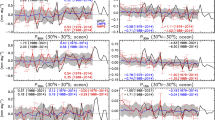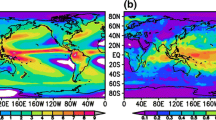Abstract
Interactions between oceanic heat transfer and the formation of the fields of spatial geopotential gradients in the middle troposphere has been studied using linear regressive analysis. The analysis of the spatial distribution of coefficients of correlation shows that heat fluxes in the Northern Atlantic play a significant role in the formation of circulation features of the middle troposphere over the Atlantic–European region, which indicates the possible predictability of large-scale characteristics of circulation due to oceanic processes.
Similar content being viewed by others
References
O. A. Razorenova, “Large-scale interaction of the ocean and atmosphere in the North Atlantic. I. Analysis of relationship between oceanic heat flow and characteristics of circulation in the middle troposphere by linear correlation,” Meteorol. Gidrol., No. 9, 77–86 (1998).
O. A. Razorenova, “Large-scale interaction of the ocean and atmosphere in the North Atlantic. II. Implementation of canonic correlation for analysis of interaction between ocean and atmosphere,” Meteorol. Gidrol., No. 10, 69–80 (1998).
A. I. Ugryumov, Doctoral Dissertation in Geography (Leningrad, 1986).
J. Bjerknes, “Atlantic air-sea interaction,” in Advances in Geophysics (Academic, New York, 1964), Vol. 10, pp. 1–82.
S. K. Gulev, M. Latif, N. Keenlyside, et al., “North Atlantic Ocean control on surface heat flux on multidecadal timescales,” Nature 499, 464–467 (2013). doi: 10.1038/nature12268
S. K. Gulev and K. P. Belyaev, “Probability distribution characteristics for surface air-sea turbulent heat fluxes over the global ocean,” J. Clim. 25 (1), 184–206 (2012).
J. W. Hurrell, “Decadal trends in the North Atlantic oscillation: regional temperatures and precipitation,” Science 269, 676–679 (1995).
E. Kalnay, W. Collins, S. Saha, et al., “The NCEP/NCAR 40-year reanalysis project,” Bull. Am. Meteorol. Soc. 77 (3), 437–471 (1996).
S. Kravtsov and S. K. Gulev, “Kinematics of eddymean flow interaction in an idealized atmospheric model,” J. Amos. Sci. 70, 2574–2595 (2013). doi: 10.1175/JAS-D-12–0309.1
S. Saha, S. Moorthi, H.-L. Pan, et al., “The NCEP climate forecast system reanalysis,” Bull. Am. Meteorol. Soc. 91 (8), 1015–1057 (2010). doi: 10.1175/2010BAMS3001.1
Author information
Authors and Affiliations
Corresponding author
Additional information
Original Russian Text © O.A. Razorenova, P.A. Shabanov, 2015, published in Okeanologiya, 2015, Vol. 55, No. 6, pp. 888–892.
Rights and permissions
About this article
Cite this article
Razorenova, O.A., Shabanov, P.A. The role of oceanic heat fluxes in formation of fields of geopotential gradients in the middle troposphere. Oceanology 55, 801–804 (2015). https://doi.org/10.1134/S0001437015060156
Received:
Published:
Issue Date:
DOI: https://doi.org/10.1134/S0001437015060156




